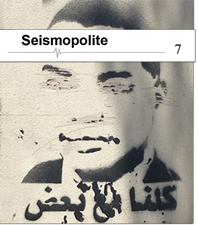July 6, 2014
Violence and Light
Richard Mosse's Infra (2010-11)
Written by Carmen Victor
In 2010 Irish photographer Richard Mosse travelled to North and South Kivu provinces in the Eastern Congo to photograph the human and physical landscape using Aerochrome III Infrared film. Aerochrome, a film stock manufactured by Kodak, was developed in conjunction with the US military during the Cold War era.[i] The film stock is referred to as false-colour reversal film (also called colour-infrared) because it reflects the infrared spectrum, a light spectrum that falls below the spectrum of what can normally be perceived by the human eye. When objects are photographed using Aerochrome, the infrared spectrum is rendered visible and appears in shades of red, visible reds appear green and greens appear blue. Developed prior to digital photography, Aerochrome was a tool in military surveillance practices.
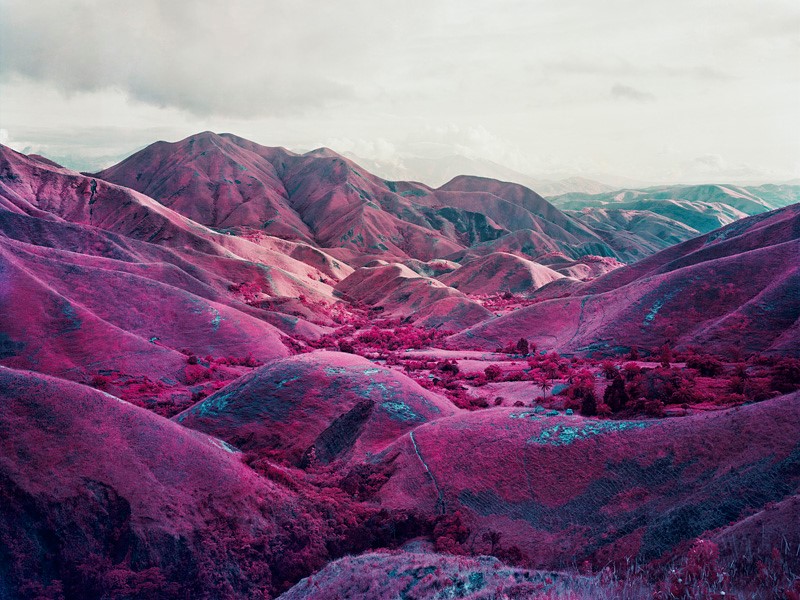
Originally, the film was mounted in cameras on airplanes and used to detect enemy infrastructure located within heavily vegetated areas. However, in 2009 Kodak discontinued manufacturing Aerochrome. According to Mosse, the attraction of using an obsolete film stock derives from a reading of Conrad’s Heart of Darkness (1899) in which Conrad, as Marlow, writes: “We were cut off from the comprehension of our surroundings; we glided past like phantoms, wondering and secretly appalled.”[ii] Furthermore, in an author’s note published in the 1917 edition of Heart of Darkness, Conrad states:
It is like another art altogether, that somber theme had to be given a sinister resonance, a tonality of its own, a continued vibration that, I hoped would hang in the air and dwell on the ear after the last note had been struck.[iii]
Richard Mosse expressed a need for an appropriate form to better describe this ‘sinister resonance’. He found that by using Aerochrome film, it fulfilled a desire to pursue something ineffable.
The works produced during Richard Mosse’s visits to the Congo resulted in two bodies of work. One is Infra (2010 - 2011) from which several large-scale images were included in an exhibition titled PUBLIC: Collective Identity | Occupied Space, [iv] an exhibition whose curatorial premise was to highlight how photography shapes collective experience and to articulate tensions that arise from the occupation of space. It is not a coincidence that the Latin translation for the prefix ‘infra’, means below. Not only does Mosse refer to the infrared spectrum of light rendered visible through the use of Aerochrome film stock to generate these images, but the title also makes reference to the way in which the conflict has fallen below the radar, so to speak, in terms of eliciting a response from the international community and suggests that the complexity of the conflict in Congo is incongruent with media attention which seems to privilege conflicts that are simpler to explain.[v] Furthermore, the title Infra refers to Giorgio Agamben’s concept of homo sacer, in which homo sacer are people who are set outside human jurisdiction without being brought into the realm of divine law.[vi] The other body of work Mosse produced in the eastern Congo is The Enclave (2013), a multi-media film installation that was exhibited at the Pavilion of Ireland for the 55th Venice Biennale.
The Democratic Republic of Congo has had the highest number of direct and indirect civilian deaths since World War II. According to the International Rescue Committee, an international non-governmental organization that provides humanitarian aid to refugees forced to flee from war, the number of fatalities is estimated to be between 2 and 15 million, and of those fatalities 5.4 million deaths have occurred since 1998. The conflict in the region dates back to Europe’s initial contact with the Congo region in 1492.[vii] The Congo basin was annexed by King Leopold II of Belgium and endured decades of dictatorships as well as fallout from the Rwandan genocide in the 1990’s. The conflict persists to the present day. By photographing the eastern Congo using Aerochrome film, Richard Mosse attempts to make this largely invisible, centuries-old conflict – visible.[viii]
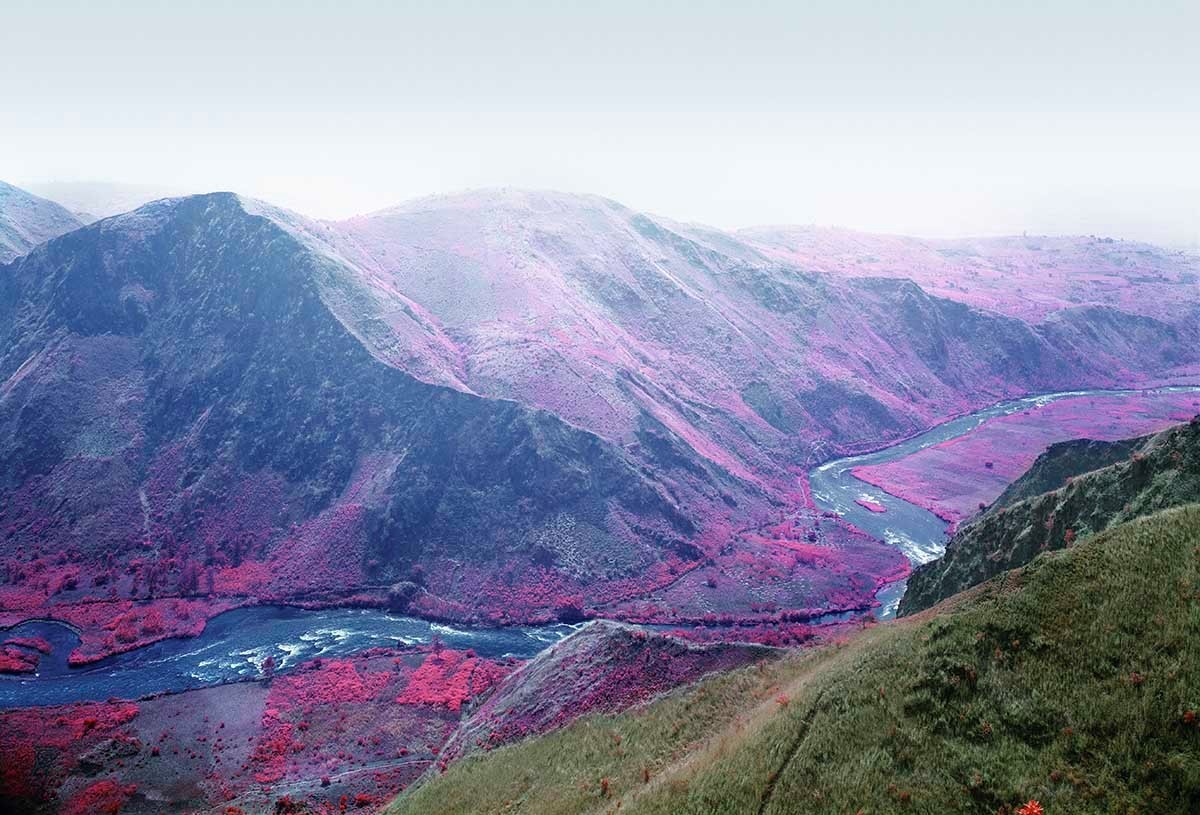
The provinces of North and South Kivu measure roughly 125,000 square kilometers[ix] and share borders with Rwanda, Uganda, Burundi and Tanzania. During the 1993-4 genocide in Rwanda, the majority Hutus massacred the ruling Tutsi minority who had been in power for centuries.[x] Approximately one million exiled Tutsi fugitives and refugees migrated to North Kivu and displaced the Congolese Hunde that lived there and survived primarily on subsistence farming. Tutsi and Hutus are pastoralists; they clear the jungle in order to raise cattle. From encampments in North Kivu, the Tutsi would launch violent incursions into Rwanda against the Hutus. At the time, the Congolese government was largely at a standstill due to the thirty-year rule of Mobuto Sese Seko. The lush landscapes represented in Richard Mosse’s photographs are in fact sites where ethnic cleansing, violent tribal massacre and sexual violence occurred. At present, the factions survive by smuggling diamonds, copper, zinc and tin from the occupied regions. The mining is artisanal and is often undertaken by children living in abject poverty.
In many ways, the sustained conflict in Congo represents catastrophic consequences resulting from the smooth functioning of our own political and economic systems. According to categories Slavoj Žižek elaborated upon in Violence (2008), the conditions in the eastern Congo could be characterized as a manifestation of systemic violence: Centuries of economic vampirism and cultural and political disparagement, constituting an invisible background which manifests itself in irrational explosions of violence, dispensed by armed militia who are constantly shifting alliances. This invisible backdrop of systemic violence should be taken into account in attempts to make sense of the explosions of subjective violence that span centuries in the Congo.[xi]
In Mosse’s photographs. the picture plane acts as a mirror that reflects the landscape, marked by violence. It implicates the viewer as a witness to and enabler of the violent landscape. This oscillation wavers between violence inherent in the landscape and the violence caused by our collective (Western) distraction. Viewing these works in the non-violent context of a safe, climate-controlled art gallery, in itself creates a paradoxical effect: It reaffirms the viewers’ feeling of complicity in the violence that precipitated these images.
By virtue of the highly saturated colour gradation induced by colour-infrared, the affect inherent in these images draws the eye. The images attract the viewer and hence render the conflict more visible and more invisible at the same time. Invisible, because we are simultaneously attracted and distracted by the lush quality of the images. Visible, because a valid reading of the work is impossible without knowledge of the systemic violence that is represented in them and that caused their very production.
Congo’s annexation by Belgian King Leopold II could be characterized as an instance of Benjaminian law-making, mythic violence which became divine. In Critique of Violence Benjamin makes the following statement: “Its power is formless, like its nowhere-tangible, all-pervasive, ghostly presence in the life of civilized states.”[xii] Although Benjamin was describing state-authorized police violence, Leopold certainly dispensed bloody power over mere life for its own sake, and yet it was proposed as pure power over all life for the sake of the living.[xiii] The moment at the Berlin Conference of 1885 when Leopold had himself declared the unilateral proprietor of Congo through political subterfuge changed everything with lasting and dire consequences. With regard to Leopold, Žižek states:
The fact that Belgian king Leopold II who presided over the Congo holocaust was a great humanitarian and proclaimed a saint by the Pope cannot be dismissed as a mere case of ideological hypocrisy and cynicism. Subjectively, he may well have been a sincere humanitarian, even modestly counteracting the catastrophic consequences of the vast economic project which was the ruthless exploitation of the natural resources…the country was his personal fiefdom![xiv]
Leopold’s autocratic reign, a realization of systemic violence turned divine, was authorized by European colonial countries and the United States at the Berlin Conference of 1885, where the International Congo Society was recognized as sovereign over the territories it controlled. The process was not instantaneous although its eventuality constitutes divine violence. In 1876 Leopold founded the International African Society and within that organization, created the supposedly humanitarian Committee for the Study of Upper Congo. In 1878 the committee was renamed the International Congo Society, the International Africa Society was secretly bought out and subsequently folded by Leopold. The entities’ names were purposely similar in order to obfuscate the legal and bureaucratic process for Leopold to personally acquire a colony. Leopold’s totalizing reign supplanted law-making, systemic violence, and became divine violence. Richard Mosse alludes to divine violence in his account of the production of the works:
…and so I became enthralled by Aerochrome’s inflation of the documentary, mediating a tragic landscape through an invisible spectrum, disorienting me into a place of reflexivity and skepticism, into a place in consonance with my impenetrable, ghost-like subject…I had privately reached a kind of messianic state where I no longer cared to perceive the absurdity of my task.[xv]
After Leopold’s sovereignty was sanctioned over the Congo in 1885, Leopold renamed the Congo Basin area the Congo Free State and initiated the process of extracting natural resources (ivory, rubber,[xvi] minerals) using the enslavement of the Congolese population to carry out the brutal and often fatal physical labour. The country’s entire economic system constituted a deployment of Benjaminan divine violence. Leopold’s interests in financial self-enrichment began with harvesting ivory, but that was quickly usurped by development of the global the rubber industry. All the while Leopold kept the profitability of the Congo as secret as possible; the Congo state did not publish budgets.[xvii] Extraction of minerals and forced-labour mining came later. Congo is a resource-rich geographic area, however, none of its resources have managed to remain in Congo or served to benefit its populace. Leopold never travelled to the Congo, though he pillaged it unrestrained from 1870 - 1909. Recounting the BrusselsInternational Exposition, a World’s Fair that took place in 1897 where Leopold displayed a human zoo of 267 Congolese people, Adam Hochschild explains:
The Congo in Leopold’s mind was not one of starving porters, raped hostages, emaciated rubber slaves, and severed hands. It was the empire of his dreams, with gigantic trees, exotic animals, and inhabitants grateful for his wise rule. Instead of going there, Leopold brought the Congo – that Congo…to himself.[xviii]
Leopold undertook deliberate gestures à propos fostering his profile in Belgium. He built monuments, palace wings, museums and pavilions throughout the country and for this he was known as the Builder-King. A notable example of the architecture Leopold commissioned was the construction of Le Cinquantenaire. Leopold personally funded the construction of this monument to celebrate Belgium’s 50th anniversary of independence from the Netherlands. It was built using funds that were obtained from the violent and totalizing exploitation of Congolese human labour and natural resources.[xix] The Congolese are not mentioned anywhere on Le Cinquantenaire as contributors,[xx] although its construction, and that of all the monuments bestowed on Belgium during Leopold’s life, were possible because of Leopold’s absolute domination of Congolese natural and human resources. In 1908, the year before Leopold’s death, Congo became colonial property of Belgium rather than simply Leopold’s personal property. Throughout Leopold’s reign and in the aftermath, the Congolese had no freedom, no justice and no political rights. They represent an embodiment of what Giorgio Agamben termed homo sacer.[xxi]
…the realm of bare life - which is originally situated at the margins of the political order – gradually begins to coincide with the political realm, an exclusion and inclusion, outside and inside…enter into a zone of irreducible indistinction. At once excluding bare life from and capturing it within the political order, the state of exception actually constituted, in its very separateness, the hidden foundation on which the entire political system rested.[xxii]
Although Belgium realized it was systematically depleting the Congolese population, it still devoted a nominal amount of resources to the Congolese. Pressure began in 1950 to allow Congo to be a self-governing state and emancipation was eventually granted in 1960. At that time there were only 36 university graduates from any African country in Congo, and no Congolese had been trained as doctors or engineers,[xxiii] issues that further contributed to the bare life existence of the Congolese population.
The violent history of the Congo was reinforced by Victorian-era conceptions of race that were characteristic of the colonial era. Leopold referred to Congo’s forced labourers as les libérés in a misrepresentation of language that Hochschild states is analogous to Arbeit Macht Frei that was written above the gate at Auschwitz.[xxiv] Žižek would characterize these instances as further evidence of symbolic violence, where violence is embodied in language. Another example of a perversion embedded in language is the unilateral designation of Swahili as the official regional language, an act determined by the wielders of colonial powers. Even the Congolese rebels' naming of their weapon was a result of intervention by colonial powers: theyrefer to their machetes as les armes blanches, bladed weapons of metal that reflect the light, that leave no perceptible trace on the land.
Mosse uses a large-format, bellows camera in order to take the infrared photographs.[xxv] This is because Aerochrome III must be kept at a cold temperature due to the fugitive nature of the film stock and refrigeration is a difficult condition to maintain in a sub-Saharan war zone. Mosse, in essence, also shoots blind because the infrared elements are not visible until the film has been developed and printed.[xxvi] Mosse has compared his photographs with Theodore Gericault’s Raft of the Medusa (1818-1819), where contemporary political events were similarly depicted through large-scale representation. The Kantian sublime could perhaps also be a relevant concept in the attempt to describe Mosse's photographs' relation to the Congo holocaust: The massive scale in which Mosse’s photographs are rendered reinforces a"subliminal" experience, where the visible and invisible violence situated within the images exceeds rational understanding and remains beyond human comprehension.[xxvii] If we consider for a moment the sublime nature of Mosse’s photographs, we could also ask, like Jacques Rancière does:
What should we make of a photographic exhibition depicting victims of genocide? Does it count as a form of rebellion against the perpetrators? Does it amount to anything more than an inconsequential sympathy towards the victims? Ought it generate anger towards the photographer who turns the victims’ pain into an aesthetic matter?[xxviii]
According to Rancière “the element that is left over once these reactions are subtracted is the supposed ‘beauty’ or ‘power’ of the photograph itself.”[xxix] Thse words, which Rancière uses to define the aesthetic regime of art, could also well be used to describe the ambiguous power of Mosse’s photographs, as situated in between a positively immanent aesthetic and an all to overwhelming transcendence towards their political realities. Following Rancière, this “dissensus is a conflict between a sensory presentation and a way of making sense of it, or between several sensory regimes and/or bodies”[xxx]For him, as a consequence, the politics of the image lies in the production of “new configurations between the visible and the invisible.”[xxxi] Richard Mosse, for his part, is explicit about the impetus behind his work, which certainly also adds meaning to Rancière's words:
The unseen, the hidden, the invisible – these are all integral aspects of Congo’s war…their situation lies well beyond my powers of communication, yet I felt compelled to attempt to describe it. My photography there was a personal struggle with the disparity between my own limited powers of representation and the unspeakable world that confronted me.[xxxii]
Congo is caught in a relentless, cyclical procession of violence and counter-violence caused by centuries of systemic, subjective and divine violence. Violence, in Mosse’s case, is the light of revelation. The prospect of witnessing, however mediated, conflict and war is what drew him there. By stripping the veil from the object,[xxxiii] the presencing of violence in these images provokes a revelation of the veil itself.
Carmen Victor is a doctoral candidate at the York/Ryerson Joint Graduate Program in Communication and Culture. Her research is concerned with contemporary representations of landscape as a site for the integration of aesthetic, cultural and political considerations.
---
This paper was originally written for a graduate seminar at York University, Canada entitled Violence and Light, supervised by Professor Brian Grosskurth. I would like to thank Professor Grosskurth for providing the conceptual framework that informed this paper. This paper was also presented at the 3rd International Conference on Photography and Theory in Nicosia, Cyprus in 2014.
---
[i] Richard Mosse. Infra: Photographs by Richard Mosse, with an Essay by Adam Hochschild. London: Aperture Foundation, 2012, 130.
[ii] Joseph Conrad. Heart of Darkness. New York: W.W. Norton and Company Inc, 1963, 36.
[iii] Mosse, 130.
[iv] Curated by Matthew Brower, David Liss and Bonnie Rubenstein, April 28 – June 30, 2012, at the University of Toronto Art Centre in Toronto, Canada.
[v] Mosse, 129. Mosse quotes The New York Times which gave the conflict in Darfur, Sudan four times the coverage it gave Congo in 2006, although the deaths in Congo far outnumbered the deaths occurring in Darfur.
[vi] Giorgio Agamben. Homo Sacer: Sovereign Power and Bare Life. Translated by Daniel Heller-Roazen. Stanford: Stanford University Press, 1998, 52
[vii] Adam Hochschild. King Leopold’s Ghost: A Story of Greed, Terror and Heroism in Colonial Africa. New York: Mariner Books, 1998, 8.
[viii] Matthew Brower. “PUBLIC: Collective Identity | Occupied Space” Public: CONTACT Photography Festival, May 2012, 58.
[ix] Three provinces border on Lake Kivu, North Kivu, South Kivu and Maniema. The entire region was designated ‘Kivu’ under dictator Mobutu Sese Seko. Since the overthrow of Sese Seko in 1997 it has been implied that calling the region simply ‘Kivu’ is no longer appropriate to unilaterally describe three geographically large provinces.
[x] I say ‘regional’ because in 1993, before the Rwandan genocide, the Hunde who resided in North Kivu, Congo massacred the Banyarwanda (the name given by the Congolese for Tutsi and Hutu peoples living in Rwanda, they were considered non-Congolese despite having lived in Congo since its current borders were established). The history of the area is highly disputed and no one particular history is wholly accepted, but in this paper I rely primarily on accounts in Thomas Turner’s The Congo Wars, Conflict, Myth & Reality, London: Zed Books, 2007 and Hochschild’s King’ Leopold’s Ghost (1998).
[xi] Slavoj Žižek, Violence (New York: Picador, 2008). 14 –15.
[xii] Walter Benjamin. “Critique of Violence.” In Selected Writings: 1913- 1926, Volume 1, edited by Marcus Bullock and Michael W. Jennings. Cambridge: Harvard University Press, 1996: 243.
[xiii] Divine violence. Benjamin, 250.
[xiv] Žižek, Violence, 14-15.
[xv] Mosse, 131. Mosse is also referencing Derrida’s Messianic Principle from Spectres of Marx: The State of the Debt, the Work of Mourning and the New International. New York: Routledge, 1994: 65.
Awaiting without horizon of the wait, awaiting what one does not expect yet or any longer, hospitality without reserve, welcoming salutation accorded in advance to the absolute surprise of the arrivant from whom or from which one will not ask anything in return and who or which will not be asked to commit to the domestic contracts of any welcoming power (family, state, nation, territory, native soil or blood, language, culture in general, even humanity), just opening which renounces any right to property, any right in general, messianic opening to what is coming, that is, to the event that cannot be awaited as such, or recognized in advance therefore, to the event as the foreigner itself, to her or to him for whom one must leave an empty place, always, in memory of the hope—and this is the very place of spectrality.
[xvi] During Leopold’s occupation, villages were expected to deliver rubber sap quotas. If they did not deliver the required quota, colonizers would cut off individuals’ hands to demonstrate the consequences of not fulfilling quotas. Members of Leopold’s armed forces in Congo would be paid for the number of severed hands they delivered; it demonstrated they didn’t waste bullets. Hochschild’s book King Leopold’s Ghost takes its title from a poem by Nicholas Vachel Lindsay The Congo (1914) from which a stanza reads:
Listen to the yell of Leopold’s ghost
Burning in Hell for his hand-maimed host
Hear how the demons chuckle and yell
Cutting his hands off, down in Hell
This spectral/ghost theme is repeated throughout Benjamin, Hochschild, Derrida and Mosse.
[xvii] Hochschild,168. Though by the late 1890’s Edmund Dene Morel, a clerk for a shipping company whose primary client was Leopold, began to notice. Morel witnessed first-hand that arms and weaponry were the only cargo shipped from Belgium to Congo, whereas Congo was shipping raw materials to Belgium. Morel realized the Congolese were not being paid for the raw materials they supplied, they weren’t allowed to hold currency and that the entire arrangement was one of total economic and physical enslavement.
[xviii] Hochschild, 175.
[xix] See Appendix A.
[xx] BBC, “White King, Red Rubber, Black Death”, YouTube, 6:27, http://youtu.be/LcaMSPkQpFg (accessed May 17, 2013).
[xxi] Giorgio Agamben. Homo Sacer: Sovereign Power and Bare Life. Translated by Daniel Heller-Roazen. Stanford: Stanford University Press, 1998: 52.
[xxii] Agamben, 12.
[xxiii] Hochschild, 301.
[xxiv] Hochschild, 310.
[xxv] See Appendix B.
[xxvi] One shot, the infrared film is processed in New York. Richard Mosse describes the technical process in conversation with I Still Shoot Film, http://istillshootfilm.org/post/48700294601/richard-mosse-interview-kodak-aerochrome-in-the-congo (accessed August 12, 2014).
[xxvii] See Appendix C.
[xxviii] Jacques Rancière. Dissensus (London: Continuum Books, 2010), 136.
[xxix] Rancière, 136.
[xxx] Rancière, 139.
[xxxi] Rancière, 139.
[xxxii] Mosse, 131-133.
[xxxiii] Benjamin, 439.
Appendix A
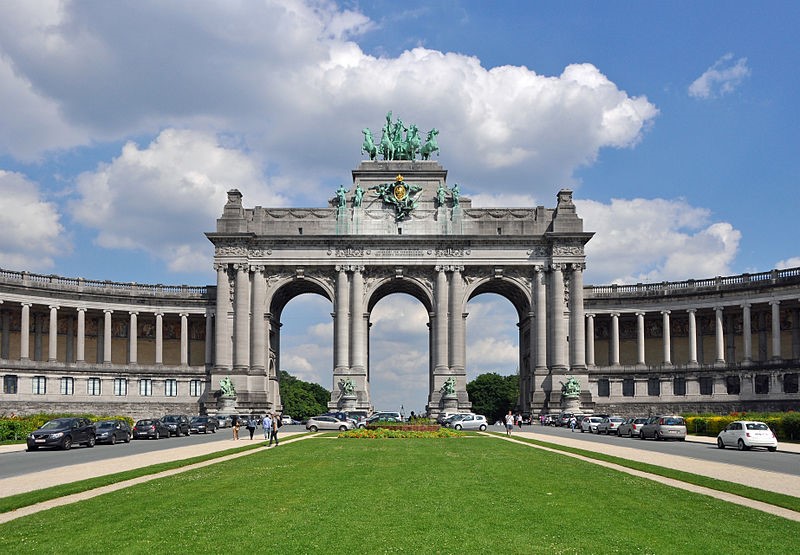
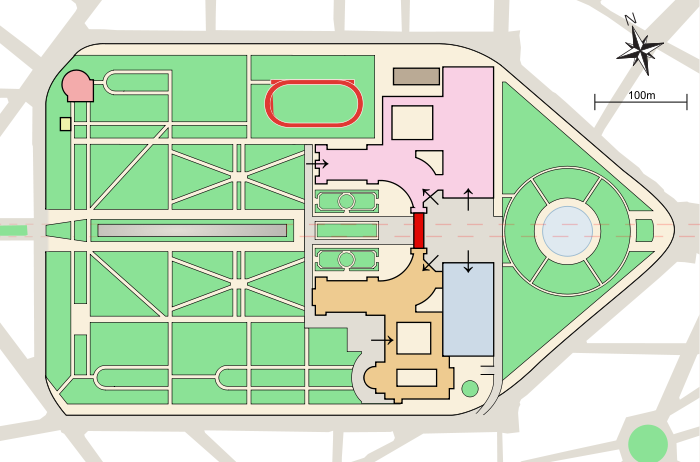
Appendix B
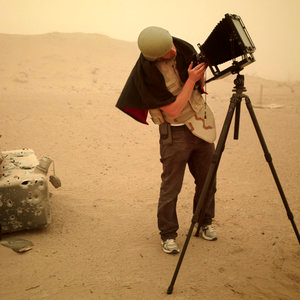
Appendix C
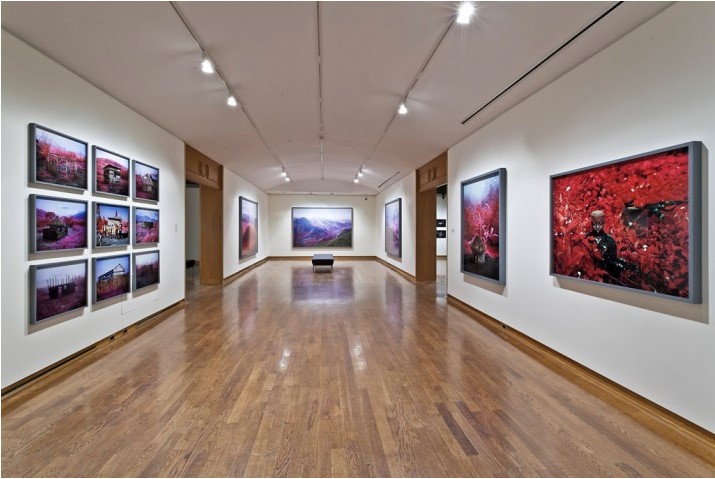
Bibliography
Agamben, Giorgio. Homo Sacer: Sovereign Power and Bare Life. Translated by Daniel Heller-Roazen. Stanford: Stanford University Press, 1998.
Benjamin, Walter. “Critique of Violence.” In Selected Writings: 1913- 1926, Volume 1, edited by Marcus Bullock and Michael W. Jennings, 236 - 254. Cambridge: Harvard University Press, 1996.
Benjamin, Walter. “The Work of Art in the Age of Mechanical Reproduction.” In The Art of Art History: A Critical Anthology, edited by Donald Preziozi, 435 – 442. Oxford: Oxford University Press, 2009.
Brower, Matthew. “PUBLIC: Collective Identity | Occupied Space” Public: CONTACT Photography Festival, 32 – 59. May 1 – 31, 2012.
Conrad, Joseph. Heart of Darkness. Edited by Robert Kimbrough. New York: W.W. Norton and Company Inc., 1963.
Deleuze, Gilles. “Postscript on the Societies of Control,” October 59 (Winter 1992): 3 – 7.
Hochschild Adam. King Leopold’s Ghost: A Story of Greed Terror and Heroism in Colonial Africa. New York: Mariner Books, 1998.
Krauss, Rosalind E. “Uncanny.” In Formless: A User’s Guide. Edited by Yves-Alain Bois and Rosalind Krauss, 192 – 197. New York: Zone Books, 1997.
Mosse, Richard. Infra: Photographs by Richard Mosse, with an Essay by Adam Hochschild. London: Aperture Foundation, 2012.
Musila, Cyril. “Kivu, Bridge Between the Atlantic and Indian Oceans,” Institut Français des Relations Nationales: Sub Saharan Africa Program (April 2009).
www.ifri.org/downloads/musilaenglishversion_2.pdf (accessed May 22, 2013).
Rancière, Jacques. “The Paradoxes of Political Art.” In Dissensus. 134 -151. London: Continuum, 2010.
Turner, Thomas. The Congo Wars: Conflict, Myth & Reality. London: Zed Books, 2007.
Žižek, Slavoj, Violence. New York: Picador, 2008.









